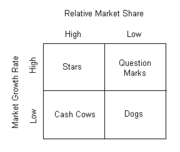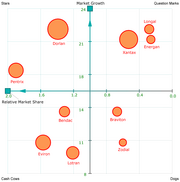Boston Consulting Group
 | |
| Company type | Private |
|---|---|
| Industry | Management consulting |
| Founded | 1963 |
| Headquarters | Boston, Massachusetts, U.S. |
Key people | Rich Lesser, President & CEO |
| Revenue | $4.55 billion (2014)[1] |
Number of employees | 6,200 consultants worldwide (10,500 total staff[2]) |
| Website | bcg.com |
The Boston Consulting Group (BCG) is a multinational management consulting firm with 82 offices in 46 countries. The firm advises clients in the private, public, and not-for-profit sectors around the world, including more than two-thirds of the Fortune 500.[3] Considered one of the most prestigious management consulting firms in a branche-internal survey,[4] BCG was ranked second in Fortune's "100 Best Companies to Work For" in 2015.[5]
History
The company was founded by Bruce D. Henderson, a Vanderbilt University and Harvard Business School alumnus. After many years in the purchasing department of Westinghouse in Pittsburgh (where pricing behavior gave him the idea of the experience curve), he joined Arthur D. Little in Cambridge, Massachusetts. He was then recruited by The Boston Company, where he founded a one-man, one-telephone consulting unit he named Boston Consulting Group.
In 1975, Henderson arranged an employee stock ownership plan, and employees took the company independent from The Boston Company. The buyout of all shares was completed in 1979.[6]
In January 2013, Rich Lesser became the sixth president and chief executive officer of BCG.
Awards and Recognitions
BCG received the top spot in Consulting magazine's 2014 "The Best Firms to Work For" ranking, released in September 2014.[7] Fortune Magazine ranked BCG second in its 2011- 2012 lists of the "top 100 best companies to work for".[8] The 2015 rankings by Fortune listed BCG as the second "best company to work for."[9] and in 2014 BCG ranked third. BCG has also been listed in Consulting magazine's "Best Firms to Work For" list every year since 2001,[10] received a perfect score on the Corporate Equality Index[11] formulated by the Human Rights Campaign for the past six years,[12] and been rated by Working Mother magazine[13] as one of the "best companies" for working mothers for the past six years.[12]
Recruitment
BCG's recruiting process is notoriously demanding, typically taking candidates through multiple rounds of case- and experience-based interviews. In 2013, career review site Glassdoor ranked BCG as the 3rd most difficult company with which to interview.[14]
Developed concepts


In 1968, BCG created the "growth-share matrix", a simple chart to assist large corporations in deciding how to allocate cash among their business units. The corporation would categorize its business units as "Stars", "Cash Cows", "Question Marks", and "Dogs" (originally "Pets"), and then allocate cash accordingly, moving money from "cash cows" toward "stars" and "question marks" that had higher market growth rates, and hence higher upside potential.[15][16][17]
Experience curve
The experience curve illustrates that the more often a task is performed the lower the cost of doing it will be. The task can be the production of any good or service. Each time cumulative volume doubles, value-added costs (including administration, marketing, distribution, and manufacturing) fall by a constant and predictable percentage.
BCG founder, Bruce Henderson, expounded the implications of the experience curve for strategy.[18] BCG research concluded that because relatively low cost of operations is a very powerful strategic advantage, firms should capitalize on these learning and experience effects.[19]
Advantage matrix
In this matrix, the two axes are economies of scale and differentiation. The four quadrants formed are called "Volume", "Stalemated", "Specialized", and "Fragmented".
Publications
Books
- Yves Morieux and Peter Tollman: Six Simple Rules: How to Manage Complexity without Getting Complicated, 2014. ISBN 1422190552
- Luc de Brabandere and Alan Iny: Thinking in New Boxes: A New Paradigm for Business Creativity, 2013. ISBN 0812992954
- Michael Deimler, Rich Lesser, David Rhodes, and Janmejaya Sinha: Own the Future: 50 Ways to Win from The Boston Consulting Group, 2013. ISBN 9781118591703
- Michael J. Silverstein, Abheek Singhi, Carol Liao, and David Michael: The $10 Trillion Dollar Prize - Captivating the Newly Affluent in China and India, 2012. ISBN 1422187055
- David Rhodes and Daniel Stelter: Accelerating Out of the Great Recession, 2010. ISBN 0071718141
- Michael J. Silverstein and Kate Sayre. Women Want More: How to Capture Your Share of the World's Largest, Fast-Growing Market, 2009. ISBN 0061776416
- Harold L. Sirkin, James W. Hemerling and Arindam K. Bhattacharya. Globality: Competing with Everyone from Everywhere for Everything, 2008. ISBN 0446178292
- Carl W. Stern and Michael S. Deimler: The Boston Consulting Group on Strategy, 2006. A collection of articles on strategy and management. ISBN 0471757225
- James P. Andrew and Harold L. Sirkin: Payback – Reaping the Rewards of Innovation Harvard Business School Press, 2006. ISBN 1422103137
- Michael J. Silverstein with John Butman: Treasure Hunt – Inside the Mind of the New Consumer, 2006. ISBN 1591841232
- Luc de Brabandere: The Forgotten Half of Change – Achieving Greater Creativity through Changes in Perception, 2005. ISBN 1419502751
- Colin B. Carter and Jay W. Lorsch: Back to the Drawing Board – Designing Corporate Boards for a Complex World, 2004. ISBN 1578517761
- Rob Lachenauer and George Stalk: Hardball – Are You Playing to Play or Playing to Win, 2004. ISBN 1591391679
- Michael J. Silverstein and Neil Fiske: Trading Up – Why Consumers Want New Luxury Goods and How Companies Create Them, 2003. ISBN 1591840708
- Jeanie Daniel Duck: The Change Monster – The Human Forces that Fuel or Foil Corporate Transformation and Change, 2002. ISBN 0609808818
- Arun Maira: Shaping the Future – Leadership through Communities of Aspiration in India and Beyond, 2002. ISBN 0471479195
- David C. Michael and Greg Sutherland: Asia's Digital Dividends – How Asia-Pacific's Corporations Can Create Value from E-Business, 2002. ISBN 0471479179
- Tiha von Ghyczy, Bolko von Oetinger, and Christopher Bassford: Clausewitz on Strategy, Wiley 2001. ISBN 0471415138
- Bolko Von Oetinger: A Passion for Ideas – How Innovators Create the New and Shape Our World, 2001. ISBN 1557532095
- Philip Evans and Thomas S. Wurster: Blown to Bits – How the New Economics of Information Transforms Strategy, 1999. ISBN 087584877X
- Carl W. Stern and George Stalk Jr. (eds.): Perspectives on Strategy from The Boston Consulting Group, 1998. ISBN 0471248339
- George Stalk Jr. and Thomas M. Hout: Competing Against Time, 1990. ISBN 0743253418
- James Abegglen and George Stalk: Kaisha, the Japanese Corporation, 1985. ISBN 0465037119
- Bruce D. Henderson: The Logic of Business Strategy, 1984. ISBN 0890115265
- Ira Magaziner and Tom Hout: Japanese Industrial Policy, 1980. ISBN 0877255156
- Bruce D. Henderson: Henderson on Corporate Strategy, 1979. ISBN 0890115265
Perspectives
In 1964 BCG began mailing concise essays designed to stimulate senior management thinking on a range of business issues.[20] The pieces would be called Perspectives. Considered provocative ideas on business, BCG founder Bruce D. Henderson referred to them as "a punch between the eyes."[20]
Example Perspectives are:
- "The Product Portfolio", 1970.[21][22]
- "The Pricing Paradox", 1970.[21]
- "The Rule of Three and Four", 1976.[23][24]
- "Sustained Success", 1984.[25]
- "Time-Based Results", 1993.[26]
Notable current and former employees
References
- ^ "BCG at a glance". The Boston Consulting Group. 2014. Retrieved 20 March 2014.
- ^ "BCG Today". The Boston Consulting Group. 2015. Retrieved 3 August 2015.
- ^ "We enable client success". Boston Consulting Group. 2014. Retrieved 20 March 2014.
- ^ "The most prestigious consulting firms". Forbes. 2011. Retrieved 20 March 2014.
- ^ "100 best companies to work for". Fortune. 2014. Retrieved 20 March 2014.
- ^ About BCG
- ^ [1]
- ^ Fortune magazine, "100 Best Companies To Work For, 2011"
- ^ Fortune magazine, "100 Best Companies To Work For, 2015"
- ^ "Consulting Magazine,". Consultingmag.com. Retrieved 2012-02-11.
- ^ "Human Rights Campaign Employer Database". Retrieved 2013-03-15.
- ^ a b "BCG Awards". Retrieved 2013-03-15.
- ^ "Working Mother". Retrieved 2013-03-15.
- ^ Glassdoor Interview Rankings
- ^ The Product Portfolio, BCG, January 1970
- ^ The Experience Curve Reviewed BCG
- ^ Fripp, Geoff.“Overview of the BCG Matrix” Guide to the BCG Matrix
- ^ Hax, Arnoldo C.; Majluf, Nicolas S. (October 1982). "Competitive cost dynamics: the experience curve". Interfaces. 12 (5): 50–65. doi:10.1287/inte.12.5.50.
- ^
Henderson, Bruce (1974, #149). "The Experience Curve Reviewed: V. Price Stability" ([PDF] Reprint). Perspectives. The Boston Consulting Group. Retrieved March 24, 2007.
{{cite news}}: Check date values in:|date=(help)[dead link] - ^ a b "BCG History Timeline". Retrieved 2013-03-08.
- ^ a b "BCG History Timeline". Retrieved 2013-03-08.
- ^ "The Product Portfolio". Perspectives. The Boston Consulting Group. Retrieved 2013-03-08.
- ^ "BCG History Timeline". Retrieved 2013-03-08.
- ^ "The Rule of Three and Four". Perspectives. The Boston Consulting Group. Retrieved 2013-03-08.
- ^ "BCG History Timeline". Retrieved 2013-03-08.
- ^ "BCG History Timeline". Retrieved 2013-03-08.
This article needs additional citations for verification. (March 2009) |
